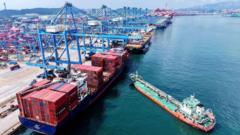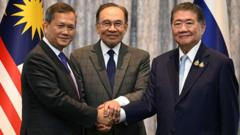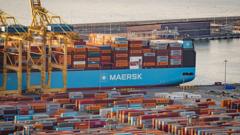Trump's tariffs impose severe challenges on South East Asian economies, particularly Vietnam and Cambodia, jeopardizing their export-driven growth and political stability as they seek negotiations with the U.S.
South East Asia Faces Economic Challenges Amid Trump's Tariffs

South East Asia Faces Economic Challenges Amid Trump's Tariffs
As Trump's tariffs take effect, Vietnam and its neighbors like Cambodia face significant economic strain, jeopardizing growth plans and reliance on U.S. exports.
The economic successes of South East Asia, particularly Vietnam, have long been fueled by robust exports to the United States. However, the introduction of sweeping tariffs by former U.S. President Donald Trump is set to disrupt this growth trajectory. Vietnam and Cambodia are among the countries facing the harshest tariffs, with rates as high as 46% and 49%, respectively, while other nations in the region, like Thailand and Indonesia, are also experiencing significant levies.
Historically, the region has thrived on exports, with the U.S. market accounting for a substantial share of its GDP—23% for Vietnam and 67% for Cambodia. Nevertheless, the imposition of these tariffs threatens to hinder this progress. The adverse implications could be especially pronounced for Vietnam, which aspires to develop into a high-income, tech-driven economy by 2045. As part of its strategy, the nation has sought to strengthen trade ties with the U.S., a key component of its Comprehensive Strategic Partnership established in 2023.
Despite needing to rely less on U.S. exports than Vietnam, Thailand, too, finds itself under economic pressure, grappling with a decade of underperformance and setbacks from the tariffs. Likewise, the Cambodian government, already facing political challenges under new leadership, risks destabilization as job losses mount, particularly in the garment sector, which is critical for the livelihoods of many.
In response to these tariffs, countries like Vietnam, Thailand, and Cambodia have turned to negotiation rather than retaliation. Leaders have reached out to the U.S., proposing concessions such as tariff reductions and increased imports of American goods. However, skepticism from U.S. trade officials, who argue that Vietnam's offers are inadequate, indicates that negotiations may prove fruitless.
The impact of these tariffs is not uniformly felt across the region; for example, Malaysia is less affected due to its lower export dependency on the U.S. Meanwhile, the complications extend to Myanmar, where high tariffs on low-GDP exports highlight ongoing struggles in the war-torn nation.
In an ironic twist, Trump's initially favorable perception among regional leaders now contrasts sharply with the current urgency for tariff relief. With economies hanging in the balance, the hope for a resolution rests on the effectiveness of diplomatic negotiations with the U.S. as they navigate this challenging economic landscape.



















